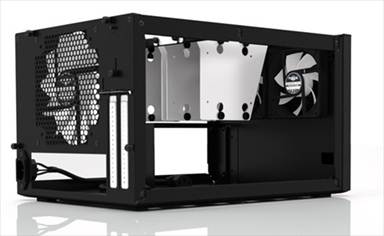Well-made, compact and affordable, but GPU
cooling is lacking
While Fractal Design's Define and Arc
series of cases have consistently impressed over the last few years, the
Node304 is the company's first mini-ITX chassis to support full ATX power
supplies and large graphics cards. Looking to strike a balance between
thesuper-teenySilverStoneFT03-Mini and the heftier BitFenix Prodigy, the Node
304 displays Fractal Design's trademark understated design, with its
brushed-aluminum front fascia.
The curved front plate enables vented
sections in the top and bottom of the fascia to allow dust-filtered airflow to
pass through a pair of 90mm intake fans located behind it. Meanwhile, there's a
blue power LED sits at the bottom right, with a pair of USB 3 ports, a power
button, and the requisite 3.5mm microphone and headphone jacks tucked around
the right side of the fascia.

Fractal
Design Node 304
The exterior is also dotted with vented
sections to improve airflow; a long dust-filter-equipped vent runs along the
left side panel, servicing the GPU fitted behind it, while a small unfiltered
vent on the right side panel, and a filtered vent on the case's floor, serve
the laterally mounted PSU. Meanwhile, a 140mm cooling fan sits at the rear, as
well as an intake fan to provide airflow over the motherboard. This means that
the Node304 relies entirely on its three intake fans and the positive pressure
they create to expel hot air.
The external paneling is made from a single
sheet of metal, which slides off in one piece to reveal the internal frame. The
motherboard is fitted to the floor of the case at the rear, with the PSU placed
laterally across the front of the chassis inside a small internal bracket. To
keep the 3-pin power socket to the rear, Fractal Design has included an
internal 90-degree extension cable, with the vented sections in the case's
exterior providing plenty of airflow for the PSU.
Meanwhile, hard drive storage is provided
by a trio of white drive hangers suspended above the PSU. Drives are fitted
using rubber vibration-dampening grommets, and each caddy also supports 2.5in
drives should you wish to fit a sextet of SSDs. However, the left hard drive
cage must be removed in order to accommodate full-sized graphics cards; this
means that, with a full-specification system, you'll only to be able to fit
four drives. Bravely, Fractal Design has also chosen to ditch the 5.25in mount,
not even offering a slim line optical drive fitting; however, considering the
decreasing relevance of physical media, we can't disagree with that decision.

Each
caddy supports 2.5in drives, should you wish to fit a sextet of SSDs.
With the PSU and storage all at the front,
Fractal Design has left 165mm of headroom for CPU coolers. With the rear fan
mount right next to the motherboard, it's also ideally placed for
single-radiator all-in-one liquid cooler kits. However, there are fewer
positives regarding the PSU and graphics card arrangement, as longer GPUs will
stray into the cables of even short PSUs. Officially, Fractal states that cards
longer than 170mmwillconflictwith PSUs longer than 160mm, as the PSU then
extends into the graphics card's space, but you can fit a much larger graphics
card inside if you use a shorter PSU. However, our 140mm test PSU's cabling
soon found itself coiled up right next to our 267mm-long GeForce GTX 570 1.3GB.
This blocked airflow to the end of the card, and it's even difficult to avoid
this with a fully modular PSU, as the two components are in such close
proximity.
Other than the conflict between the
graphics card and PSU, building a PC inside the Node 304 proved to be very
simple. With nothing mounted in the exterior shell, you can perform all the
required cable-tidying and routing with ease, and the front-panel connectors
are long enough to snake right around the motherboard. With no side panels or
roof in place, it's easy to reach inside and tuck cables and connectors into
place too, something that certainly wasn't the case with confined chassis such
as the Lian Li PC-TU200.
Despite its trio of intake fans, however,
the Node 304's cooling left us a little deflated. CPU cooling was decent, with
a delta T of 46°C being 3°C cooler than either the SilverStone FT03-Mini or
Lian Li PC-200, but 3°C warmer than that of the BitFenix Prodigy. It was GPU
cooling that soured the situation, though, with a delta T of 63°C being 15°C
hotter than the Prodigy-it was also the highest result on test. All three fans
were reasonably quiet, but the proximity of the PSU and GPU, and the resulting
cable build-up, clearly impacted the graphics card's cooling, despite the large
side-panel vent. Basically, this is really only a case for small graphics
cards, whichever PSU you're using, and this gives it a distinct disadvantage.

Despite
its trio of intake fans, however, the Node 304's cooling left us a little
deflated
Conclusion
With Fractal Design's typical minimalist
looks and sensible layout, we had high hopes for the Node304. Sadly, its poor
GPU cooling let it down, although it rallies well with solid CPU cooling thanks
to its trio of cooling fans. While the Node 304's overall build quality is
superior, the BitFenix Prodigy is cheaper, cooler and more flexible, leaving
the Node304 in second place.
Pros and cons
Nodal: Well
priced; compact; good CPU cooling; room for all-in- one liquid coolers
Noodle: PSU
cables conflict with graphics card; poor GPU cooling
How much?
Price: $108 inc
VAT
Scores
Cooling: 20/30
Features: 15/20
Design: 27/30
Value: 16/20
Overall: 78%
|